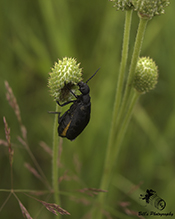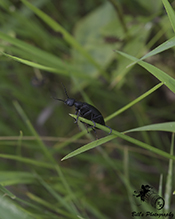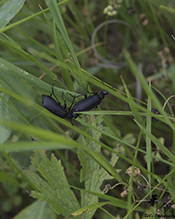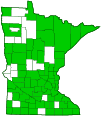burning blister beetles
(Epicauta spp.)
Overview • Description • Distribution • Taxonomy
Description |
Adults are ⅛″ to 11⁄16″ (4 to 18 mm) in length. The body is elongate, slender, and soft. The head is broad and somewhat rectangular when viewed from above. It is distinctly separated from the first segment of the thorax (prothorax) by a short neck. The antennae have 11 segments and on most species they are thread-like. The mouthparts are directed downwards. The upper plate covering the prothorax (pronotum) is narrower than the head and narrower than the base of the wing covers (elytra). It is rounded on the sides. The elytra are soft and leathery. They are loosely rolled over the body on the sides. They cover most of the body but leave the tip of the abdomen exposed. The legs are long and slender. On the front legs, there is a patch of silky hairs on the underside of the third segment (femur). On the front and middle legs, the last part of each leg (tarsus), corresponding to the foot, has 5 segments. On the hind legs the tarsus has just 4 segments. |
Distribution |
||
|
Sources |
|
| 8/16/2025 | ||
Occurrence |
||
|
||
Taxonomy |
|
Order |
Coleoptera (Beetles) |
Suborder |
Polyphaga (Water, Rove, Scarab, Long-horned, Leaf, and Snout Beetles) |
Infraorder |
Cucujiformia |
Superfamily |
Tenebrionoidea (darkling beetles and allies) |
Family |
Meloidae (blister beetles) |
Subfamily |
Meloinae |
Tribe |
Epicautini |
Subordinate Taxa |
|
Subgenus Epicauta Subgenus Macrobasis |
|
Synonyms |
|
Anomalonychus Anomalonyx Apteropasta Apterospasta Causima Causima Epiacuta Gnathospasta Henous Isopentra Macrobasis Maculicauta Nomaspis Pleuropompha |
|
Common Names |
|
burning blister beetle |
|
Glossary
Elytra
The hardened or leathery forewings of beetles used to protect the fragile hindwings, which are used for flying. Singular: elytron.
Femur
On insects and arachnids, the third, largest, most robust segment of the leg, coming immediately before the tibia. On humans, the thigh bone.
Pronotum
The exoskeletal plate on the upper side of the first segment of the thorax of an insect.
Prothorax
The first (forward) segment of the thorax on an insect, bearing the first pair of legs but not wings.
Tarsus
On insects, the last two to five subdivisions of the leg, attached to the tibia; the foot. On spiders, the last segment of the leg. Plural: tarsi.
Visitor Photos |
||
Share your photo of this insect. |
||
This button not working for you? |
||
Bill Reynolds |
||
 |
 |
|
 |
 |
|
MinnesotaSeasons.com Photos |
||
|
||
|

Slideshows |
|

Visitor Videos |
||
Share your video of this insect. |
||
This button not working for you? |
||
|
Other Videos |
||
|

Created: 7/28/2017 Last Updated: © MinnesotaSeasons.com. All rights reserved. |


